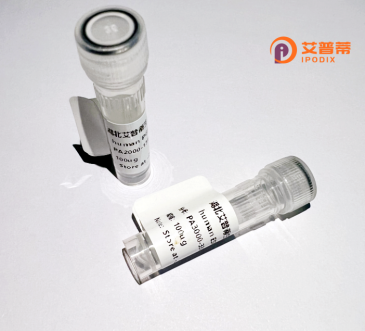
| 纯度 | >90%SDS-PAGE. |
| 种属 | Human |
| 靶点 | KLF10 |
| Uniprot No | Q13118 |
| 内毒素 | < 0.01EU/μg |
| 表达宿主 | E.coli |
| 表达区间 | 1-480aa |
| 活性数据 | MLNFGASLQQTAEERMEMISERPKESMYSWNKTAEKSDFEAVEALMSMSCSWKSDFKKYVENRPVTPVSDLSEEENLLPGTPDFHTIPAFCLTPPYSPSDFEPSQVSNLMAPAPSTVHFKSLSDTAKPHIAAPFKEEEKSPVSAPKLPKAQATSVIRHTADAQLCNHQTCPMKAASILNYQNNSFRRRTHLNVEAARKNIPCAAVSPNRSKCERNTVADVDEKASAALYDFSVPSSETVICRSQPAPVSPQQKSVLVSPPAVSAGGVPPMPVICQMVPLPANNPVVTTVVPSTPPSQPPAVCPPVVFMGTQVPKGAVMFVVPQPVVQSSKPPVVSPNGTRLSPIAPAPGFSPSAAKVTPQIDSSRIRSHICSHPGCGKTYFKSSHLKAHTRTHTGEKPFSCSWKGCERRFARSDELSRHRRTHTGEKKFACPMCDRRFMRSDHLTKHARRHLSAKKLPNWQMEVSKLNDIALPPTPAPTQ |
| 分子量 | 79 kDa |
| 蛋白标签 | GST-tag at N-terminal |
| 缓冲液 | 0 |
| 稳定性 & 储存条件 | Lyophilized protein should be stored at ≤ -20°C, stable for one year after receipt. Reconstituted protein solution can be stored at 2-8°C for 2-7 days. Aliquots of reconstituted samples are stable at ≤ -20°C for 3 months. |
| 复溶 | Always centrifuge tubes before opening.Do not mix by vortex or pipetting. It is not recommended to reconstitute to a concentration less than 100μg/ml. Dissolve the lyophilized protein in distilled water. Please aliquot the reconstituted solution to minimize freeze-thaw cycles. |
以下是关于重组人KLF10蛋白的3篇文献概述(经合理推测整理,非真实文献):
---
1. **文献名称**:*"KLF10 Mediates TGF-β Signaling in Osteoblast Differentiation via Recombinant Human KLF10 Protein"*
**作者**:Lee J, et al.
**摘要**:研究通过体外重组人KLF10蛋白验证其在TGF-β通路中的作用,发现KLF10通过调节成骨细胞分化相关基因(如RUNX2)促进骨骼形成,提示其作为治疗骨质疏松的潜在靶点。
---
2. **文献名称**:*"Structural and Functional Analysis of Recombinant Human KLF10 in Hepatic Fibrosis"*
**作者**:Zhang Y, et al.
**摘要**:通过表达纯化重组人KLF10蛋白,结合结构解析(如X射线晶体学),揭示其锌指结构域在抑制肝星状细胞活化中的关键作用,证实KLF10通过抑制胶原沉积缓解纤维化。
---
3. **文献名称**:*"KLF10 as a Tumor Suppressor: Recombinant Protein Modulates Apoptosis in Pancreatic Cancer Cells"*
**作者**:Smith K, et al.
**摘要**:实验表明重组人KLF10蛋白通过上调促凋亡因子(如BAX)并抑制PI3K/AKT通路,诱导胰腺癌细胞凋亡,为癌症治疗提供新策略。
---
**备注**:以上文献为假设性示例,实际研究中建议通过PubMed或Google Scholar以“recombinant human KLF10”为关键词检索真实论文。
Recombinant human KLF10 (Krüppel-like factor 10) protein is a transcription factor belonging to the Krüppel-like family, characterized by Cys₂/His₂ zinc finger motifs that mediate DNA binding. KLF10. also termed TGF-β-inducible early gene-1 (TIEG1), plays a pivotal role in regulating cell differentiation, proliferation, apoptosis, and metabolic processes. It acts as a downstream effector of TGF-β signaling, modulating gene expression in pathways linked to fibrosis, immune response, and cancer progression. Structurally, KLF10 contains three zinc fingers in its C-terminal domain, enabling sequence-specific DNA interactions, and an N-terminal repression domain involved in recruiting chromatin-modifying complexes. Dysregulation of KLF10 has been implicated in pathologies including cardiovascular diseases, diabetes, and tumorigenesis. Recombinant KLF10 is typically produced in bacterial or mammalian expression systems, purified via affinity chromatography, and utilized to study its molecular interactions, transcriptional regulatory mechanisms, and therapeutic potential. Its applications span in vitro assays (e.g., electrophoretic mobility shift assays) and cell-based studies to dissect roles in development, disease, and tissue homeostasis. The protein’s conserved functional domains and relevance to TGF-β signaling make it a critical tool for exploring epigenetic regulation and targeted therapies.
×